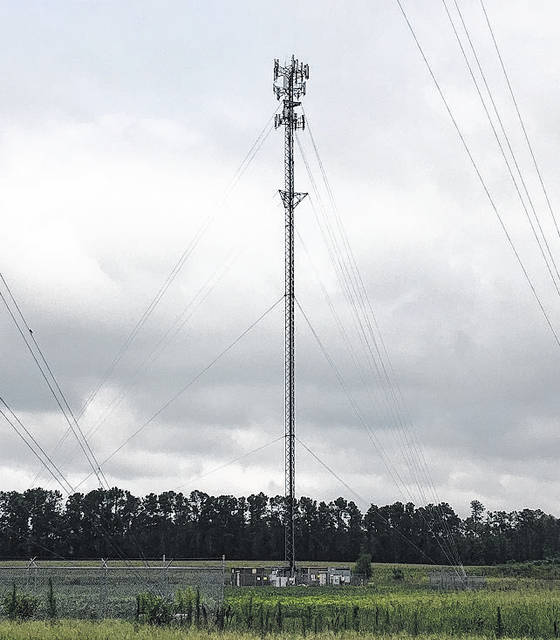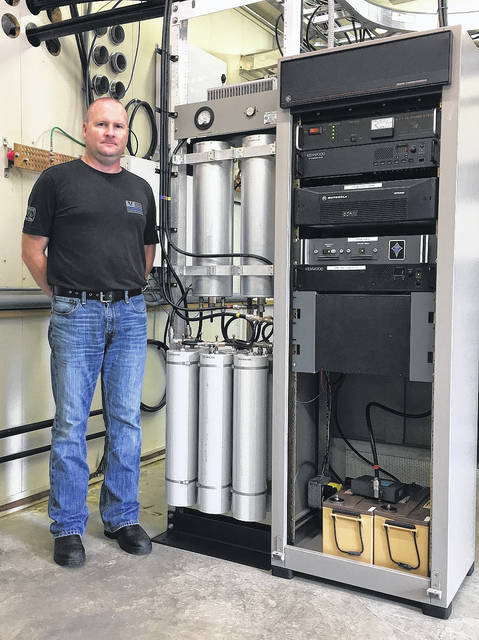The way we communicate with each other has changed tremendously over the past few decades, but amateur radio operators or “hams,” are still utilizing reliable, analog point-to-point technology to aid in emergency communications.
Derek McIntyre, N4DBM, an amateur radio operator for 32 years, saw a need in Bladen County when he moved to the area in 2005. At the time, the county did not have a ham radio repeater of its own.
“There were and still are other ham radio repeater stations in neighboring counties for us to use at our leisure or during times of emergency situations,” says McIntyre, “but we needed one of our own — something local that our folks could use within their reach.”
McIntyre works for the State Highway Patrol VIPER Group. Emergency communications is something he does not take lightly.
In short, a repeater system is essentially a base station that is usually located atop a high tower or structure that relays audio from one location to another. Hams use a repeater to extend their range using “walkie-talkie” radios or fixed mobile units to relay voice to the repeater. The repeater then broadcasts that voice communication to all other stations that are set to receive the repeater’s output.
This is done with the use of very elaborate equipment that allows the repeater to both receive and transmit simultaneously through the use of an antenna combiner system called a duplexer.
“The goal is to have as much usable coverage as possible, while having the repeater station itself physically and electrically built like a tank,” McIntyre says. “We want to have a repeater that receives other stations clearly and at the same time have enough transmitter power to broadcast just as far. We want it to be dependable and reliable, too. The antenna and tower infrastructure has to survive the elements and be designed to handle multiple direct lightning strikes while staying in operation.”
Bladen County’s first VHF ham repeater was installed in 2007 atop the county courthouse, thanks to cooperation of county officials to aid in the process. In June 2018, a completely new repeater system was installed at a higher tower just south of Elizabethtown.
McIntyre says the repeater’s antenna is at a lofty 400 feet and right out the very top of the tower. It provides mobile radio coverage to hams up to 40 miles in every direction, and portable hand-held radios can reach the station up to 15 miles away. The equipment that builds up the system can be quite expensive. However, not one dollar was spent on the entire setup.
McIntyre says most ham radio repeater builders rely on acquiring outdated or abandoned equipment from local municipalities.
“We take the stuff apart, repair it, and modify it to make it what we want,” McIntyre said. “Hams will gladly take most any sort of junked equipment. We are kind of like an electronics salvage yard. We like the challenge of making things work out of whatever we have.”
The repeater is on backup generator power and was used to relay emergency traffic during Hurricane Florence last year. The emergency command center at the courthouse would periodically call and listen for stations that needed assistance or had radio traffic to pass along when cellular service was out.
“We actually had a fellow on I-95 near Lumberton who had no phone service while on the road. He used our repeater to confirm that he had just rescued a family whose vehicle became stranded due to flooding roadways,” McIntyre remembers. “He was able to communicate with us and others in the area using his ham radio through our system. Luckily, we were able to guide him where he needed to go and eventually get that family home safely.”
McIntyre said the repeater is not on the air solely for emergency purposes.
“We use it daily to chat with folks in our area or people just traveling through,” he said. “It’s especially useful in the summer time with travelers going to and from the beach and those vacationing in White Lake. We welcome anyone with a valid ham radio license to call out on the repeater and check in with us. We’re a friendly community.”
Using the system on a daily basis ensures proper operation in the event that emergency communication is needed. Hams claim it as their duty to always monitor for radio traffic on the local repeater system.
With another busy hurricane season expected this year, McIntyre says he has gone through the repeater system and others he maintains in neighboring counties, doing full, thorough alignments to be certain everything is working at its peak performance. He believes that in a world of digital media and instant communication, it is still important to keep the hobby of amateur radio alive by utilizing and maintaining old-school analog equipment.
“We, as the amateur radio community, take pride in being able to talk across the state, or even the world for that matter, without the use of land lines or cellphones,” he said. “We can throw things together at the last minute with minimal preparation time using just what we have in our parts stash.”
McIntyre recalls the big red “X” and the “no service” message displayed on his cellphone during Hurricane Matthew when so many cellular tower sites went down due to the storm.
“It’s a strange feeling when you realize you can’t call anyone; you’re disconnected in a sense, and all you can do is wait for service to come back. We have become very dependent on the cellular network. We always expect it to just work. That’s why we really need to have several forms of communication to use in the event that one fails. That’s what the ham radio community in Bladen County has succeeded in doing.”
The repeater operates on a frequency of 146.985 MHz, with a “minus 600” offset and a 162.2 Hz access tone.

The 400-foot communications tower on which the repeater is located is just south of Elizabethtown.

Derek McIntyre, with the repeater equipment and combiner system, says he wants ‘to have a repeater that receives other stations clearly and at the same time have enough transmitter power to broadcast just as far.’

